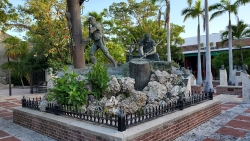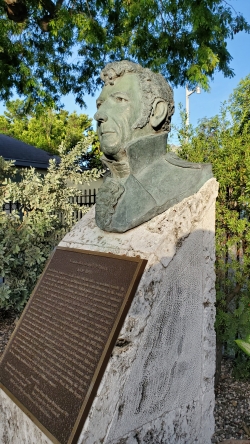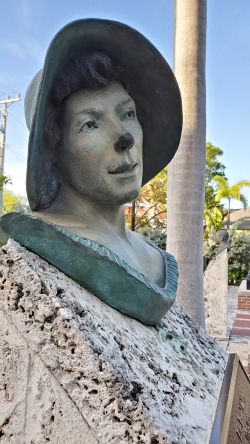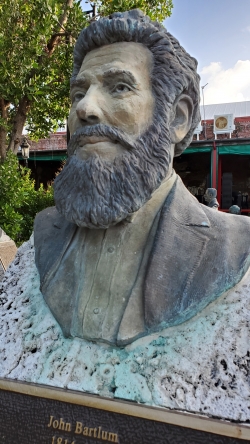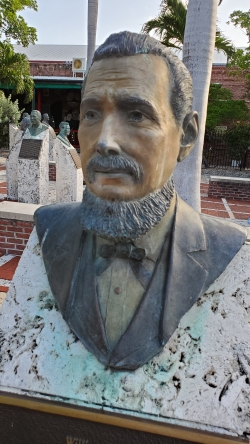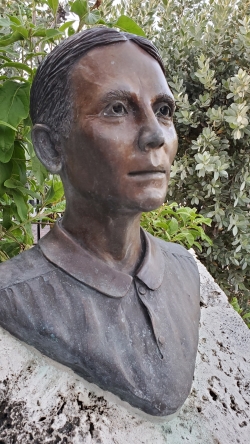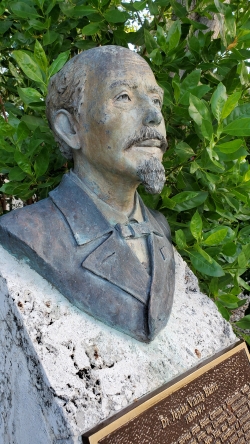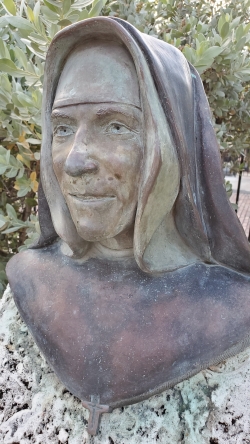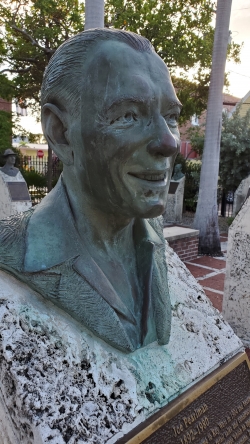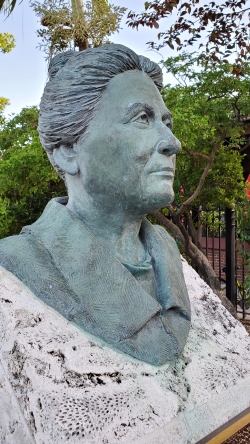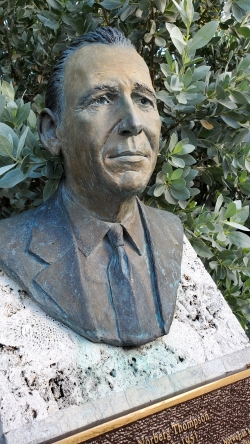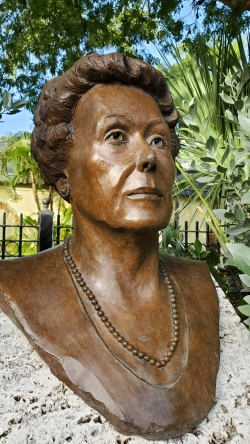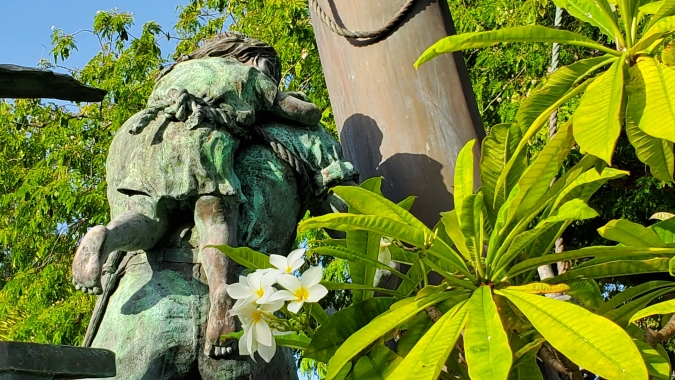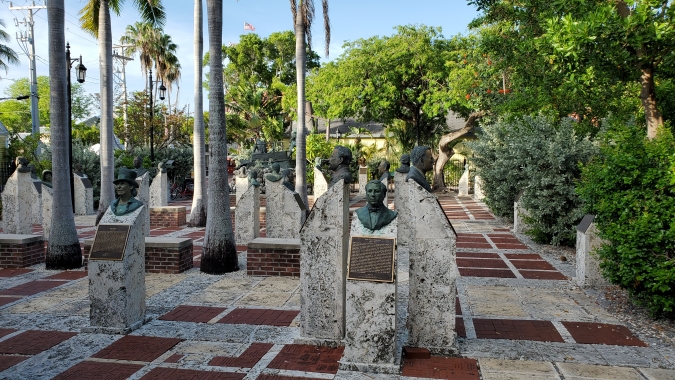The Sculpture Garden was established by City Resolution in 1995 and opened in 1997 with 36 bronze busts and biographies of the pioneering men and women who have made Key West such a vibrant and important outpost of American culture and folklore. Dominating the Garden is a 18' x 25' sculpture entitled "The Wreckers" which shows two men salvaging the remains of a sailing ship, wrecked on the notorious reef near Key West. One of the men is rescuing a young girl, her arms clutching his neck, a rope securing her to his back. Resolute heroics in word and deed.
_______________________________________________________________________________________________
The men and women who carved Key West out of rock and sand came from high and humble origins. They came from the Bahamas, Cuba, Europe and the early American states. They were merchants, surveyors, engineers, doctors, religious and common folk in search of adventure and sweat. Lots of sweat.
They came to make something out of nothing. To create an allegiance with their fellow islanders and prosper for the sake of their families and those in their charge. To this date, neither disease nor political persuasion has undermined this sense of unity and purpose.
Let's take a glance at a few of these gritty characters -
Commodore David Porter
When Commodore Porter established a Navy Station in Key West in 1823 he was already a nationally recognized figure, having served in battle versus the Tripoli pirates and in the War of 1812. This Navy Station was the first permanent settlement in Key West.
With a Mosquito Fleet of shallow draft schooners, oared barges and the USS Gull, Porter chased and eradicated piracy in the Florida Keys and West Indies. Porter's authoritarian style did not sit well in Key West or Congress and after an unauthorized altercation in Puerto Rico, Commodore Porter was court marshaled.
In 1830 Porter was appointed Counsular General in Algiers and later Minister in Turkey were he served until his death in 18 . Key West has maintained a military presence since Porter's initial Navy Base.
Ellen Russell Mallory
Ellen Russell was born in Ireland, moved to Trinadad as a teenager, married, moved to Connecticut and due to her husband's poor health came to Key West in 1823. She became a Matron/Nurse at the Navy hospital and following her husband's death operated the only boarding house in Key West.
As a nurse she was instrumental in coordinating treatment of victims of yellow fever. Russell was known for her Irish wit (aka sarcasm), kindness, empathy and sympathetic treatment of the poor and sick. Her son Stephen became a US Senator and Secretary of the Navy, Confederate States of America (CSA). Wife, mother, nurse and businesswoman - not bad for a girl from Ireland!
John Bartlum
When John Bartlum came to Key West in 1835 he was an experienced wrecker from Green Turtle Cay. Bartlum was a self taught shipwright, joined the firm of (eventually) William Curry & Sons and was soon building schooners of more than 100 tons.
His greatest achievement was the 950-ton clipper ship Stephen C. Mallory launched in 1856. The Mallory was built of a native mahogany known as Madeira and was the only ship of its size built in the south by native craftsmen.
Bartlum spurned offers to relocate by northern ship builders and when he died in 1871, every flag in Key West flew at half-mast.
William Curry
William Curry came to Key West from Green Turtle Cay at the age of 16. He was a clerk in a mercantile firm and after serving in the Seminole Wars organized the firm of Browne & Curry with Mr. G.L. Browne.
Brown & Curry owned and operated a fleet of wreckers, was a major shipbuilder in Key West and provided the financing for the clipper Stephen C. Mallory. Brown & Curry owned piers, warehouses, ice plants, railways, a ship's chandlery and all associated properties needed to take advantage of Key West's burgeoning shipping and trade industries, including cigars.
William Curry was Florida's first home grown millionaire.
Elisabetha Smith
Elisabetha Merklin left Germany at age 18 for Tampa, Fl. However, her ship wrecked in the Florida Keys. She was rescued by wrecker Peter Knight whom she married three years later. Knight died in 1851. Twice more Merklin married yet both husbands died, the second, Joseph Smith, in 1883.
Throughout these marriages Merklin had nine children, owned and operated a boarding house and made and sold cheese and noodles. When she died in 1898 she was buried alongside her first true love Peter Knight. Her children went on to establish some of the leading families in Key West.
Dr. Jeptha Vining Harris
Dr. Harris was a Southern gentleman, educated at the University of Mississippi, the University of New York, the south Carolina Medical College and University of Louisiana where he earned his M.D. Harris served in the Confederate Army and was a doctor in the Confederate Navy.
After the war Harris and his wife moved to and purchased a large tract of land in present day Miami, providing medical services to the Seminole tribe during the typhoid epidemic of the early 1870's. Harris later moved to Key West and established his medical practice.
Harris was a delegate to the Democratic National convention in 1876, was a member of the Florida House of Representatives and Superintendent of Monroe Schools from 1877 until 1887. The Harris School on Southard St., Key West is named in is honor. His home at Simonton and South Sts., the Southernmost House, is thought by some to be the most beautiful home in Key West.
Sister Louis Gabriel
Sister Louis Gabriel arrived in Key West two weeks after taking her vows as a Sister of "The Sisters of the Holy Names of Jesus and Mary" in August 1897. She was widely known throughout Key West for her devotion to education and for the caring of women, the sick and those injured during the Spanish-American War. Her school became a military hospital.
She was a tireless worker - "Better to wear out than to rust out'.
On the 25th anniversary of her vows, Sister Gabriel and the people of Key West established the Grotto of Our Lady and Bernadette. As long as this Grotto stands, the people of Key West would never experience the full brunt of a hurricane. And so it as been - Hail Mary full of Grace the Lord is with Thee ...
Joseph Pearlman
Joe Pearlman was born in Romania and came to Key West in 1904 at the age of 12. Pearlman was a leader in retail and construction. With his CBS Construction Company he built Pearlman Estates, a major development of concrete block homes that were affordable, easy to air condition and maintain.
Pearlman was President of the Retail Merchants Association, active in the Chamber of Commerce, Red Cross, Cerebal Palsy and Crippled Childrens Association and President of the Key West Rotary which, in 1978, named him their Most Outstanding Citizen.
Pearlman was President of the B'nai Zion Synagogue from 1925 until 1950, maintaining its prosperity through the Depression and WW II. The present Synagogue on United Street was built by the CBS Construction Company and opened in 1969. In respect to Mr. Pearlman, he was subsequently named a Lifetime Honorary President of the Congregation B'nai Zion.
Maria Gutsens
In 1910, Maria Gutsens, and other members of the Beneficencia Cubana, conceived of a hospital in Key West that would serve all the indigent nationalities of Key West. In 1911 the Group dedicated the Casa del Pobre, Mercedes Hospital.
The initial hospital moved from Truman Avenue to Virgina St. and into the former residence of E.H. Gato. In 1934 the Cuban government awarded Gutsens the Cross of the Order of Carlos Manuel de Cespedes for her devotion to the hospital, relentless fund raising and the caring of its patients.
Gutsens was a Matron/Nurse at the hospital until her death in 1941.
Norberg Thompson
Norberg Thompson was of Norwegian heritage, born, raised and educated in Key West. He graduated with a law degree from New York University in 1906 but returned to Key West to succeed his father as the country's largest sponge dealer.
Thompson purchased the A. Granday Turtle Canning Company, founded the Key West Box Company (cigars) and started the Thompson Fish Company, shipping Key West seafood all the way to the northeast US. His seafood enterprise was reported to be the largest south of New England.
In 1949 The Thompson Fish Company discovered "pink gold", revitalized the waterfront areas and operated barges and truck lines to Miami, bringing shrimp to all of South Florida. Thompson served on the Key West City Council, County Commission and the Everglades County Park Commission.
Margo Golan
Margo Golan and her husband moved from Chicago to Key West in 1950. Together they built the Keys Ambassador Hotel and the Holiday Inn. When the Navy Yard was decommissioned in 1969, Golan was instrumental in converting the economy of Key West into a tourism based economy.
Golan served on the Boards of the Florida Keys Memorial Hospital, Monroe County Library, Key West Hotel Motel Association and the Chamber of Commerce. Golan's extensive philanthropy extended not only to these organizations but also to almost every non-profit in the County plus to the Key West Art and Historical Society.
In 2009, Golan's estate passed to the Key West Library and to the Art and Historical Society, continuing her generousity for the causes of Key West which she loved.
James Mastin - Sculpturor
James Mastin was born in South Dakota and grew up in Los Angeles, California. He was a classically trained artist, with multiple degrees from prestigious institutes. His monumental public works of life-sized bronze and heroic figures were full of emotion.
Mastin sculpted in clay, casting his pieces in bronze using the ancient lost wax method of casting, finishing them with a chemical patina to add color and protect the pieces from the elements. Over the course of his career, Mastin created many allegorical, figurative, and abstract works exploring the human condition, in an ever-changing variety of media and styles.
Conclusion
Hard work, enterprise and generousity. The hallmarks of a successful, trusting and enduring society. We pray thee continue ...
If you have any comments or questions, please contact me here.
Good luck!





